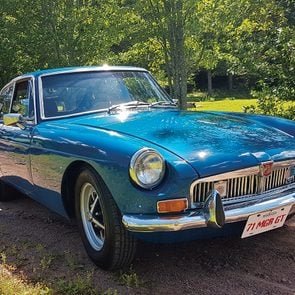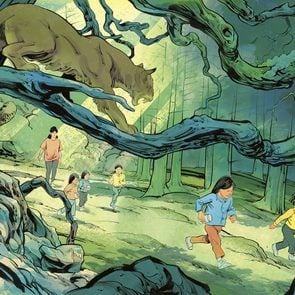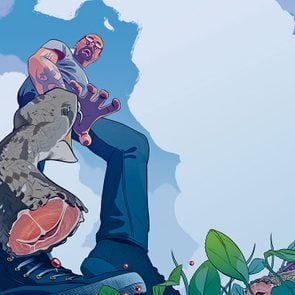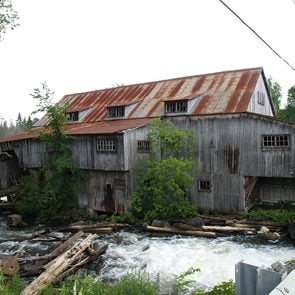Here’s a statistic to make you think: The lifetime risk for Alzheimer’s disease at age 45 is one in five for women, and one in 10 for men, according to the Alzheimer’s Association. With more than 747,000 Canadians already experiencing Alzheimer’s and countless loved ones also feeling the effects, this information can daunting.
“Alzheimer’s is a very insidious disease—it starts damaging the brain 10 years before patients notice symptoms and by that point, the damage is significant and irreversible,” explains Cassandra DeMarshall, PhD, a cell and molecular biologist who specializes in neurodegenerative diseases and the Director of Research at Durin Technologies Inc., the manufacturer of the test. “This can have a huge impact on patients and their families, yet we didn’t have an easy and reliable way to screen for it.”
But what if there were a way to know not only your risk of developing Alzheimer’s, but whether you’ve actually got the disease—years before you start to see symptoms…and in time to start treating it early?
A new blood test for Alzheimer’s disease can detect the disease in its very earliest stage and is 96% accurate, according to data published in April 2023 in the Journal of Alzheimer’s Disease.
“Now,” says Dr. DeMarshall, “with a simple blood draw, patients can screen for Alzheimer’s disease, allowing them to make better, more informed decisions about their health and starting treatment early, when it’s most effective.”
Learn to spot the early signs of dementia.
How the Alzheimer’s blood test works
When an illness, like Alzheimer’s disease, attacks your body, it causes “debris” which is then released into your blood. Your body responds to the debris by releasing “autoantibodies,” a self-reactive type of antibody that targets your body’s own proteins. These autoantibodies are released in a predictable way that creates a profile of the specific disease causing the damage.
Dr. DeMarshall and her fellow researchers found a way to identify the unique autoantibody profile for Alzheimer’s disease in the blood, allowing them to detect it long before symptoms start.
Bonus: She says that their research doesn’t just apply to Alzheimer’s disease but could be used to identify the unique autoantibody profile of many other serious illnesses, including Parkinson’s disease, ALS, schizophrenia, and even breast cancer.
When should you get tested for Alzheimer’s disease?
Most Alzheimer’s patients are diagnosed after age 65, but many researchers now believe the disease begins in the late forties to early fifties. “Ideally, we’d like people to be screened for Alzheimer’s disease annually, just like they do for heart disease and cancer, starting around age 50,” says DeMarshall.
Why get tested for Alzheimer’s if there is no cure?
At the heart of the conversation about Alzheimer’s disease testing is the painful fact that there is no cure yet for the disease. While there are some treatments that can help slow the progression of the illness, it is 100% fatal. In fact, Alzheimer’s disease is currently ranked as the ninth-leading cause of death in Canada. So if it’s progressive and you can’t cure it…do you really want to know if you have it?
This is a question Dr. DeMarshall says she hears often. Her answer is a definitive yes. “Early disease detection is a game changer for Alzheimer’s patients,” she says. “You can start treatments and lifestyle changes early, when they can have the greatest impact in slowing the disease progression.”
She adds that there are also some very promising clinical trials of Alzheimer’s treatments happening that you may qualify for. Plus, having that knowledge early can help you make smarter decisions about your healthcare and plan for your future.
How to protect your brain from Alzheimer’s disease, like a brain researcher
Regardless of whether you know you have it or not, there are things you can do today to reduce your risk of getting Alzheimer’s disease and to slow the progression if you do have it, says Dr. DeMarshall. “Anything that’s good for your heart is good for your brain, so we always recommend things like getting daily exercise and eating a nutritious diet,” she says.
What does that look like for her? “I take a 45-minute walk with my family every day after dinner,” she says. “Being outdoors, being with family, and moving your body are some of the best things you can do for your brain.”
Next, find out how this MIND Diet meal plan feeds your brain.
In 2019, Volkswagen announced that sadly, it was discontinuing the VW Beetle, after about 80 years in production.
I bought my 1963 Volkwagen Beetle for $100 in 1973, at which time it was already a rusted clunker. I knew some people, and was able to get it mechanically certified, although in retrospect, it really wasn’t roadworthy.
It was a faded steel-blue colour and had a small 1200-cc engine with minimal horsepower. A quart of oil every 100 miles or so kept the engine running.
Much of what made it special is looked at through the rear-view mirror of my life.
It had a manual transmission, which I still enjoy driving to this day. It was rusty. So rusty that the running boards (yes, it had running boards) were unsafe to step on. They had rusted away from the front fenders, and the front fenders were partially rusted away from the body, so that when I got going at any speed, the air would pool under the fenders, and make them thwap against the side of the car.
Volkswagen option packages were minimalist. On this particular 1963 Volkswagen Beetle, there was no gas gauge. It’s not as if there was a gas gauge and it didn’t work—there was no gas gauge to begin with. The way you kept track of your gas was roughly by noting how long it had been since your last fill up, and if the engine started to sputter, there was a lever on the floor that you would kick over with your foot while driving and it gave you a final gallon of gas to get you to a gas station. Very rudimentary, but it saved me numerous times.
My model didn’t have a heater fan either. The defrosting system for the front window, and heat for the whole car, was a couple of small vents at the side of the windshield. When the engine got warmed up, some heat would be directed by convection onto the windshield from these vents but not with a fan. So, in winter, there would be days when the front windshield never got totally defrosted and the interior never got warm. I kept an ice scraper handy for the inside of the window and blankets for the passengers. Winter driving was an exercise in acrobatics, steering, shifting, scraping. Texting and coffee on-the-go had not been invented yet.
I had to drive on the highway to get to my summer job, but if I got going more than 45 miles per hour, an acrid smell would creep in and the cabin would begin to fill with smoke. I stayed in the slow lane and drove with the windows open.
Near the end of the car’s life, the starter failed on it, and I didn’t have the money to fix it. Being a manual, it could be push-started. I was young and strong and the car was light. For the last few months that I owned it, I would get it rolling myself, jump in, put it in gear, pop the clutch and be on my way. I would back into parking spots at malls, so I could push it out of the spot and bump start it myself.
What I liked most, apart from the adventure of driving down the highway with the car filling up with smoke and fenders flapping in the breeze while I scraped the windshield, was the fact that the car literally came alive when I started it. There was no doubt that this car had personality! I had my VW Beetle for less than a year, but I survived the experience and I lived, loved and laughed in that car. Unforgettable times!
If you enjoyed that fond look back at the 1963 Volkswagen Beetle, don’t miss the heartwarming story behind this family’s 1950 Dodge Ram.
Having delivered the last of his explosives to seismic crews working on the Alaska Highway, Ray Kitchen, a 56-year-old trucker from Fort Nelson, B.C., decided to stop off at the Liard River Hot Springs Provincial Park. There, his 11-year-old daughter, Joline, and her friend Sarah, who were along for the ride, could enjoy a swim.
A tropic-like oasis in the boreal forest, the hot springs were a popular tourist haven complete with campsites and a playground. It was August 14, 1997.
As Kitchen relaxed beside the springs, watching the girls play, terrifying screams suddenly erupted from the park’s famous Hanging Gardens. The sound jolted Kitchen to his feet.
He rushed along a rain-slicked boardwalk and up some wooden stairs to reach the gardens’ viewing platform—and stopped, horrified. On the wooden structure, a huge bear straddled a young boy beside the motionless form of a woman. Both were covered with blood from deep gashes in their swimsuit-clad bodies.

Patti McConnell had been driving north from Paris, Texas, for over a week, heading for Alaska to start a new life. The vivacious 37-year-old mother hoped to get a job there and raise her two kids, Kelly, 13, and Kristin, 7.
It had been a tiring trip, and the children were delighted when McConnell turned off the Alaska Highway and into the Liard River park.
The family wasted no time slipping into their swimsuits, and in bare feet they hurried along the boardwalk and into the crystal-clear 53°C water of the lower pool. After a long, hot soak, they headed for the more secluded upper pool some 340 metres farther into the bush.
Kristin soon got bored and raced back along the boardwalk to the lower pool, where she’d made some friends.
“Slow down or you’re gonna slip!” McConnell yelled as her daughter tore off around a bend. She and Kelly got up to follow. As they reached the turnoff leading to the Hanging Gardens, Kelly said, “Let’s go see them, Mom.”
Climbing a flight of steps through the bush, they came to a viewing platform. So intent were mother and son on identifying the exotic plants, they paid no attention to a rustling in the bushes beside the boardwalk. McConnell glanced at her watch. “Kelly, I’m worried about Kristin. I’m going to find her.”
McConnell started down the wet steps. As she reached for the railing to steady herself, something drew her attention. She looked up into the eyes of a black bear—a big adult male sitting in the shrubbery chewing on a dogwood branch.
McConnell froze. “Kelly… bear!” she hissed.
“Sure, Mom!” With his back to her, Kelly thought she was kidding.
“Kelly!”
This time he turned round to find an animal taller than him staring intently at his mother. Remembering what he had heard about bears, he said, “Mom, don’t make any sudden movements.”
Cautiously, Kelly edged towards his mother. The bear snorted, then lunged through the railing and onto the boardwalk. “Mom! Run!”
Galvanized by her son’s screams, McConnell moved as fast as she could, the bear charging after her. She ran up the steps to the viewing platform — and was trapped.
Kelly saw in horror the bear engulf his mother’s almost naked body with its own. Despite his slight stature, the 13-year-old ran at the creature and kicked it in the face. “Get off my mom!”
The bear looked up, grunted and went back to its prey.
Searching for a weapon, Kelly snatched up a sawed-off tree limb. With a strength born of anger, he smashed at the bear’s head, all the while screaming for help.
The sight of his mother’s blood on the bear’s canines spurred Kelly on. Lunging furiously with his stick, he hit the animal squarely on the nose, drawing blood. The bear growled and swung a paw at Kelly, ripping deep claw marks into his neck and shoulders.
Then he came after the terrified boy. Kelly crumpled under the animal’s massive weight. He felt its teeth crunch around his waist as it lifted him into the air and swung him around like a dog playing with a rag doll. Just as he was about to pass out, the animal flung him to the deck. Kelly rolled into a ball.
His mother lay beside him, her skin ashen, her eyes open and unblinking. He tried to crawl towards her, but the bear pounced again, tearing chunks out of his flesh. The animal’s foul, rancid breath made Kelly want to vomit. He closed his eyes. He knew he was about to die.

Ray Kitchen quickly took in the horrifying scene. Grabbing a fallen tree branch, he hammered it against the railing.
“Hey! Get off!” he yelled. The bear paid no attention. Kitchen tore off a bigger branch and rammed it into the bear’s stomach, hoping to push the animal away from the child.
The bear rose from his victim and charged towards Kitchen. The impact knocked him right through the railing, bear and man tumbling into the bush. Clad only in his swim trunks, Kitchen tried to protect his body from the bear’s slashing claws by scrambling on his knees to a tree and covering his head with his hands. He began yelling for help.
Frank Hedingham, 71, was lounging on a deck overlooking the lower pool when he heard the screams. Just a bunch of kids, he thought. Then he heard shouts: “Help!” “Bear!” “Get a gun!” He immediately took off in their direction.
Just ahead of him on the boardwalk were Ingrid Bailey, a wilderness firefighter and paramedic from Felton, California, and her friend, Brad Westervelt. News that a rogue bear was about had spread quickly, and frantic people were fleeing towards the parking lot.
But Bailey, who regularly parachuted into fires in remote areas, was used to bears. She, Westervelt and Hedingham pressed on, gathering sticks and chunks of wood as they ran.
At the viewing platform, they saw two bloodstained bodies on the deck. But it was the terrifying scene below the deck that riveted them. Kitchen, still alive, was struggling weakly. The bear’s jaws were clamped tight around his upper arm and shoulder, its claws slashing at his already torn and bloody body.
Bailey began hurling her chunks of wood at the bear. “Get off him!” she screamed, stamping her feet and pounding the railing with a stick. She felt no fear, just anger, then helplessness as her efforts did nothing to distract the animal.
Hedingham and Westervelt, meanwhile, had spotted a long, thick tree trunk. It was heavy and cumbersome, but they levered it over the railing. Using it as a battering ram, all three heaved together, but that, too, failed to drive the animal off.
We need a gun, Bailey thought desperately. Where’s the park ranger?
As if reading her thoughts, Westervelt dropped his end of the tree. “I’m going to find a ranger,” he yelled and raced off. Hedingham, with a history of heart attacks, was exhausted but vainly continued to pound away at the bear.
Suddenly the bear shifted its position, clamped its jaws around its victim’s neck and threw him into the air. “No!” Bailey screamed frantically.
The bear hesitated and dropped Kitchen to the ground. His face gouged, his windpipe ripped out, his neck almost severed, Kitchen was dead.
Bailey turned to the other victims. She knelt beside McConnell and felt for a pulse. She knew the woman was dead, but her training dictated that she try to resuscitate her. She set to work.
Just then Kelly moaned, and Hedingham rushed to his side.
Suddenly the bear’s left paw curled over the edge of the deck centimetres from Kelly’s feet.
Furious, Hedingham stood up and delivered a vicious kick with his hiking boots. The animal staggered back, but instead of retreating, it moved down the slope towards the boardwalk, where people were still passing.
Hedingham turned back to the boy, who was trying to crawl to his mother. “Help my mom,” he pleaded in a whisper.
“Don’t worry,” Hedingham said. “We’re doing all we can. You mustn’t move. Breathe slowly.”

Hedingham, who had first-aid training, took a handkerchief from his jacket to mop blood from the worst of the gashes. “What we really need,” Bailey said, “are towels to act as compresses and two more pairs of hands for CPR.”
As if in answer, several men bounded up the stairs. One had a towel and knew CPR (cardiopulmonary resuscitation). He helped Hedingham bind the boy’s wounds. Another man assisted Bailey, compressing McConnell’s chest while Bailey breathed into her mouth.
The bear had gone. But where was the ranger? Bailey wondered.
“We must get them to hospital,” Hedingham said desperately. “I’m going for help.”
Suddenly, new screams rang through the trees. Oh, God, Hedingham thought, the bear’s at it again!
Arie Van Der Velden, 28, a research assistant from the University of Calgary, had been soaking in the upper pool when he became aware of a commotion coming from the bush. Along with other bathers, he left the pool and hurried down the boardwalk. He had almost reached the turnoff to the Hanging Gardens when someone yelled: “A bear’s coming! Run for your lives!”
Everyone turned and ran, but Van der Velden slipped and fell into the bush. In seconds the bear was there and launched itself on top of him, slashing at his body. Van der Velden kicked the animal’s nose, he even tried pulling the bear’s ears, but nothing could deter the beast. Van der Velden felt a searing pain as the bear’s claws hooked into his flesh, and then the bear bit deep into his left thigh.
Dave Webb, a 49-year-old businessman from Fairbanks, Alaska, had just arrived at the park when an exhausted man dripping blood from his temple ran up. “You’ve got to do something. There’s a bear up there!” Hedingham panted, explaining what had happened. Webb nodded, raced back to his motor home and brought out two rifles—a Winchester 30.30 and a Remington 2.23.
To a young man standing nearby, he shouted, “Do you know how to use a gun?”
“That 30.30 I do,” said Duane Eggebroten, 27. They loaded up and set off at a run down the boardwalk.
Eggebroten arrived at the scene first. He heard low groans coming from below the boardwalk. The bear now had Van Der Velden propped against a log and was feeding on him. Eggebroten aimed carefully for the back of the bear’s neck, then fired. The bear slumped down. Eggebroten knew it was dead, but he fired twice more to be sure.
Up on the viewing platform, Bailey, still tending to McConnell and her son, heard the shots. All the pent-up tension and anger poured out of her. “Shoot it again!” she cried. “Shoot it again!”
The horror at Liard River Hot Springs was finally over.
Patti McConnell died that afternoon. But thanks to the courage of Ray Kitchen, Ingrid Bailey, Frank Hedingham and the others, Kelly McConnell and Arie Van der Velden survived. Flown out to a hospital, they both eventually recovered from their terrible wounds.
In Fort Nelson on August 22, 1997, more than 500 mourners turned out to honour the bravery of Ray Kitchen. In a letter to Kitchen’s wife, U.S. President Bill Clinton wrote, “The heroism and selflessness that your husband displayed coming to the aid of Patti and Kelly McConnell is an example of all that is noble and good in human nature.”
From Canada, Kitchen received the Star of Courage posthumously in September 1998. Frank Hedingham, Kelly McConnell, Ingrid Bailey and Brad Westervelt were also awarded decorations for bravery.
Read on for more Drama in Real Life.

What to do after you’ve spilled coffee on a laptop
Switch the laptop off
Shut down the laptop. Pressing and holding the power button for five seconds is quickest. Remove the power cord, unplug any peripherals and remove the battery. The biggest danger at this time is the device shorting out.
Remove excess liquid from the laptop
Blot up excess liquid with a soft lint-free cloth or paper towels. Do not use a wiping motion as that just spreads the liquid further.
Turn the laptop over
With the laptop facing away from you, tilt it from side to side and from front to back in a gentle rocking motion to help the liquid to escape from all four sides.
Use compressed air to dry the laptop
Make sure that you have removed all excess liquid. Then, if you have one, use a can of compressed air to help dry the laptop. Alternatively, use a hair dryer on its coolest setting: keep the dry moving all the time and hold it at least 20 centimetres (8 inches) above the laptop.
Leave laptop to completely dry out
Leave the laptop opened in an inverted “V” shape in a warm area, to completely dry out. Do not leave it in direct sunlight or on a radiator. Wait for 24 hours or longer, making sure the keyboard is completely dry, before reinstalling the battery and peripherals.
If you must replace your laptop keyboard
Most laptop keyboards can be replaced by a technician, or you can purchase a new USB or wireless keyboard to use with the laptop.
Now that you know what to do when you’ve spilled coffee on a laptop, find out what those F1-F12 keys actually do.

One pool length at a time. Formerly afraid of deep water, I was now a woman on a mission. Was I training for a swimming competition? No, I was getting ready to see the big trees of Avatar Grove on Vancouver Island. On the occasion of our wedding anniversary last July, my husband Rob and I opted out of seeing man-made creations in the cities of our other possible destination choices—Denmark and Belgium—and chose instead to appreciate God-made wonders in our own Canada.
As a somewhat out-of-shape college teacher, my dream, as well as Rob’s, was seeing the big trees of Avatar Grove, the kind of trees it would take several people to encircle if their arms were outstretched. Swimming was building my cardio so I would no longer be out of breath climbing three flights of stairs to my college office—or hiking a trail.
On this week-long vacation, we were not content to drive our rental car out to the forests for a few photos. We would be going with professional guide and nature photographer TJ Watt of Big Tree Tours. We had never seriously hiked before, yet nothing could stop us from exploring this stunning patch of Canada, except acquiring good hiking shoes first!
Discover more great Canadian hikes.

Welcome to Avatar Grove
On the appointed day, we entered the Avatar Grove, a protected forest near Renfrew, B.C., with TJ, as well as one last minute but very welcome additional hiker, Val. This was my first glimpse of the big trees and as I craned my neck upwards I kept exclaiming “Oh, wow!” We’d hike awhile and I’d repeat it; on it went all day long. Nothing prepared us for the visual impact of being surrounded by these giants or the tranquil quiet that the old growth forest exuded. TJ informed us of the meaning of “old growth,” which we learned means that the massive trees are untouched survivors of storms, fires and, most of all man, through the centuries.
I stretched my arms out towards the first big tree we were introduced to and gave it an affectionate hug.
Find out what’s it’s really like living on Vancouver Island.
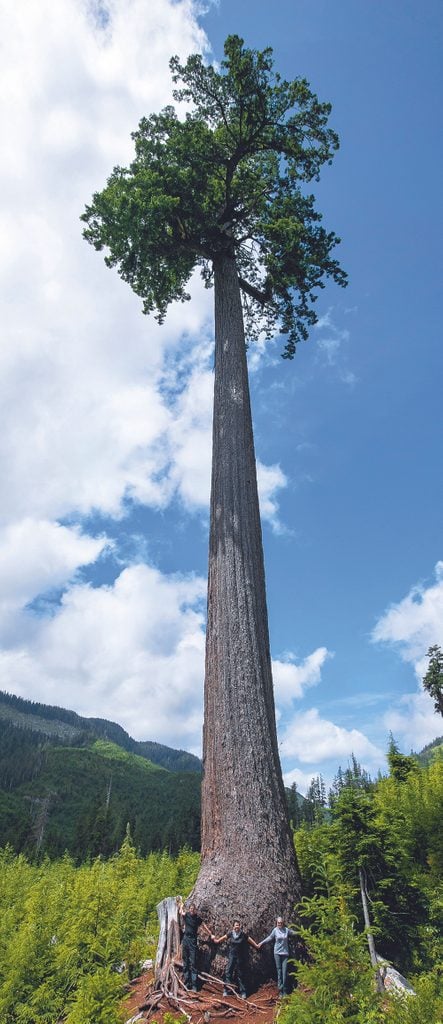
Big Lonely Doug
We had heard a CBC podcast about “Big Lonely Doug,” an old-growth Douglas fir tree that stands well over 200 feet tall, singly exposed on logged terrain. We had the privilege of meeting 1,000-year-old Doug, which was indeed the very kind of tree it would take several people to encircle if their arms were outstretched. According to TJ, people have different reactions. For me personally, it was a sad and a glad moment. Sad because this Douglas fir was alone, whereas all the other trees around it were originally cut down due to clearcut logging. Glad because Doug was spared and now apparently brought focus to the uniqueness of old-growth forests.
Here are 10 great Canadian podcasts worth adding to your playlist.

While hiking through Eden Grove, an unprotected old-growth forest nearby, TJ commented that Doug would have originally been in surroundings such as this. Taking many moments to pause on our way out, reflecting that this might be our last time in the area, none of us wanted to leave the presence of these big trees.
We concluded our day by driving along the curves, hills and switchbacks of the picturesque route from Port Renfrew to Victoria for the remainder of our vacation.
I’ve travelled to approximately 30 countries in my lifetime, but Canada remains one filled with natural beauty, adventure and history for me to discover. I’m still swimming, and getting ready for our next travels.
Adding Avatar Grove to your own bucket list? Check out 25 more essential experiences on Vancouver Island.

Canadian travel influencers worth following
Travel influencers come in all ages and life stages, from parents who travel the world with little ones in tow to golden age adventurers spending their retirement years on the road (and in the skies!). Here are 10 noteworthy globetrotters guaranteed to spark your wanderlust—and maybe even inspire you to grow your own Instagram following.
View this post on Instagram
Travel With Kevin and Ruth
Kevin and Ruth Read are redefining what it means to be retired. This adventurous Canadian couple, originally from Ottawa, live most of their life in a motorhome, exploring the world and sharing details of their off-the-beaten-path adventures on Instagram and their blog, where they attract more than 2,000 devoted readers every day. Think you need to slow down when you hit 60? Kevin and Ruth will teach you how to keep your foot on the motorhome gas pedal of life.
Here are 10 Canadian road trips everyone should take at least once.
View this post on Instagram
Jake & Marie
Have you ever travelled to a special place you loved so much, that you started planning a return the minute you got home? For Jake and Marie, that special place is the whole of Canada. These outdoorsy influencers have travelled the country from coast to coast eight times (and counting), discovering something new on each pass, from the best road trip routes to the prime camping spots and the most rewarding hikes. On Instagram, they offer stunning photos and tips and tricks in equal measure.
View this post on Instagram
Travels With Baggage
So much of travel is about mindset. What sets Jody Robbins apart? The Calgary-based Canadian travel influencer says “yes” to life, which leads her on many adventures with her husband, daughter and dog, including rock climbing in the Canadian Rockies, glamping on the southwestern shores of Nova Scotia and standup paddle boarding in Hawaii. Jody says it best: “Whether it’s luggage, time or just life, I cram as much as possible into small compartments.”
Check out Jody’s guide to the best things to do in Jasper.
View this post on Instagram
The Planet D
Of all the travel influencers in Canada, Dave Bouskill and Deb Corbeil, better known as The Planet D, are the most accomplished globetrotters. They’ve visited more than 120 countries on all seven continents, shared countless photos, articles, travel itineraries and YouTube videos and have amassed more than 200,000 followers on Instagram alone. The Planet D are currently taking a break to focus on health, but have a canoe trip to the Amazon in the works, as well as adventures in Belize and Portugal. “There is still so much more to see and many more mountains to climb,” Deb writes in a recent Instagram post.
View this post on Instagram
Krista’s Compass
Ever feel as though you’re stuck in a rut? Give Krista Hamelin a follow. The Quebec native is on a mission to live a life that her “soul craves,” replete with thrills and epic views. Though Krista’s passion for travel was first ignited in 5th grade during a family trip to the Canadian Rockies and later rekindled during a class trip to Panama as a teenager, she still found herself in a dark place as a young adult, depressed and chasing a career in a field she didn’t enjoy. Thankfully, travel got her back on track. By sharing breathtaking photos from her journeys and offering helpful travel tips, this Canadian travel influencer strives to inspire others to follow their dreams and discover their own purpose.
Don’t miss this dreamy gallery showcasing Canada’s most beautiful places.
View this post on Instagram
Lori Sweet and Sylvio Roy
Lori Sweet and Sylvio Roy give “highflying couple” a whole new meaning. Hailing from Kingston, Ontario, these travel influencers love nothing more than embarking on aerial adventures, whether it’s exploring remote islands or admiring breathtaking landscapes from above. What’s even more impressive than this couple’s knack for seeking out adventure is their talent for sharing it with others. As travel writers and photographers, Lori and Sylvio have a unique ability to capture their experiences with stunning photos and captivating stories that will leave you yearning to embark on your own journey.
View this post on Instagram
Rachel Barkman
Rachel Barkman is less of a travel influencer in the traditional sense and more of a guide to the hidden beauty of the B.C. wilderness. Set in lush forests, Rachel’s photos are infused with a deep appreciation for the natural world, capturing details like the intricate texture of tree bark and the unusual alignment of mini mushrooms taking up residence on a moss-covered log. It’s not surprising to learn that she considers her photos “love letters to the forest.”
Discover 25 responsible ways to explore the magic of Vancouver Island.
View this post on Instagram
Globe Guide
What do you do when you a) love adventure, and b) tend to suffer from travel FOMO (fear of missing out)? If you’re anything like Calgary-based journalist and travel influencer Tamara Elliott, it means you spend every waking minute on the hunt for fascinating new people to meet, new wines to savour and new cultures to experience. Whether she’s exploring her own backyard in Alberta, embarking on a European road trip, or venturing to remote locations like Uyuni, Bolivia, the founder of Globe Guide offers savvy travel tips and unique experiences you’ll be adding to your bucket list.
View this post on Instagram
Argen Elezi
You don’t need to travel to far off destinations to experience beauty. Toronto-based influencer Argen Elezi proves travel is a mindset: sometimes we just need to escape our ordinary routines and perspectives to experience the extraordinary. From the way snow clings to Toronto park benches in winter to the way asphalt glows under Vancouver street lights at night, Argen captures the stunning landscapes and the everyday beauty we’re often too busy to appreciate.
Don’t miss these inspired day trips from Toronto.
View this post on Instagram
LDH Retired and Travelling
Canadian travel influencers Linda and David are the ultimate thrill-seeking retirees. Though they’re technically based in Toronto, they only seem to live there long enough to plan their next exhilarating excursion. Linda has piloted planes and has even been known to jump out of them (150 times and counting). Her husband, David, a retired navy diver, is just as fearless. As you’ll find on their lively blog, they’re always on the lookout for new whitewater kayaking spots, luxury cruises and fun experiences to satisfy their need for speed (and chocolate).
Next, check out the 10 places in Canada every Canadian needs to visit.

It’s March 29, 2016, and to Josée Scantland and Patrick Grondin, the sunlight pouring into the CHU Sainte-Justine pediatric hospital centre in Montreal feels brighter than ever.
Their five-year-old daughter, Élissa, is about to be brought out of the operating room after receiving a new heart. Outside the OR, the couple is bursting with joy as a TV camera zooms in. “Our daughter is going to live again!” Josée exclaims. “Thank you to the donor’s family,” adds Patrick. “We don’t know you, but you can be proud. You saved our child’s life.”
Some 200 kilometres away in Gatineau, just across the Ottawa River from the nation’s capital, Michel Carpentier and Danielle Lafrance are glued to the screen, moved to tears by the story. Just a few days earlier, they made the decision to donate the organs of their 23-year-old daughter, Emmanuelle, who died by suicide; they had found her lifeless body in the garage of their family home. “She was so sensitive and wanted to save the world,” her mother recalls. And so they chose to offer eight of her organs for transplantation.
Now, seeing Élissa’s parents so happy allayed some of their grief: In death, Emmanuelle had saved the lives of whoever had received her organs. What they didn’t know was that the heart beating in Élissa’s chest was actually their daughter’s.

The year she was born, Élissa Grondin underwent two open heart surgeries to correct congenital anomalies. She’d led a normal life until the age of four, when she was struck by a virus that damaged her heart. Confined to the intensive care unit of the CHU Sainte-Justine hospital, she spent seven nightmarish months waiting for a donor.
In the five weeks leading up to the transplant, she was kept alive by a mechanical heart and couldn’t leave her hospital bed. “The blood clots that formed in the tubes of the machines could have killed her at any moment,” says Josée. Convinced only a miracle could save their daughter, Élissa’s parents spent their days by her side and retreated to the nearby Ronald McDonald House to rest when they could.
Then, on March 28, 2016, just as it seemed all hope was gone, a doctor summoned them to a small lounge area next to their daughter’s room. Their prayers had been answered: A donor heart had finally been found. Élissa would be getting it the very next morning. Following whoops of elation, Josée and Patrick spent the hours before Élissa was taken into the operating room gripped with anxiety. “It was her last chance,” says Patrick.
Eight hours later, the transplant was deemed a success.

In 2021, 409 patients of all ages in Quebec received a transplant—thanks to 144 individuals, only four of whom were pediatric donors (those under the age of 18). Each year, the names of roughly 15 kids are added to the transplant waitlist, and around the same number get a new lease on life, since one deceased patient can donate up to eight organs.
“On average, children under five have to wait more than a year for a heart transplant, as their condition grows increasingly critical,” says Dr. Marie-Josée Raboisson, cardiologist at the CHU Sainte-Justine. Often the only way to keep them alive is to temporarily implant a Berlin Heart ventricular assist device (VAD), but there are risks involved, and it isn’t always an option for patients with malformations.
“About half the parents of deceased children decline to donate the organs, often because they don’t want the body to be cut up,” says Dr. Matthew Weiss, medical director of organ donation at Transplant Québec and a pediatric intensive care physician at the CHU de Québec. “The reality is that the surgery is performed very respectfully.”
All pediatric hospitals have trained nurses whose role is to reassure families and provide them with information about the circumstances (brain death and cardiac death) that made the donation possible, and about the retrieval of organs. They explain to consenting parents that the child’s body will remain on artificial support in the intensive care unit for a few days while compatible recipients are found.
“In some cases, the wait can become unbearable, and the parents change their minds,” adds Weiss. “They are devastated, and they need time to think,” acknowledges Dr. Saleem Razack, former director of pediatric critical care medicine at the Montreal Children’s Hospital. “Others refuse owing to their religion or beliefs.”
Still, those who consent are unanimous in their conviction that helping another child heal while experiencing such a profound loss is the most meaningful choice they could have made.
Maxime Lapointe Bélair and his wife agree. Their four-year-old daughter, Raphaëlle, passed away from a respiratory infection at the CHU de Sherbrooke on February 23, 2019. When she was declared brain dead, a nurse suggested they might want to speak with Marie-Pier Savaria and her husband Benoît Lefebvre.
After Marie-Pier and Benoît’s eight-year-old son, Justin, drowned in a Sherbrooke pool on June 17, 2017, the couple went on to create a foundation that encourages organ donation. “It doesn’t solve everything, but organ donation does give the death meaning,” says Marie-Pier.
On the days when Maxime is overwhelmed with sadness, he clings to words Marie-Pier shared with him: “Instead of five families mourning the loss of their child, it’s only ours. That’s why organ donation is worth it.”

School awareness campaigns are one way to increase the number of pediatric transplants, says Raboisson. The hope is that young people then discuss it at home with their parents.
For Dr. Pierre Marsolais, intensive care physician at Sacré-Coeur hospital in Montreal, identifying those potential donors is key. He looks to Spain, a world leader in organ donation since 1992, when it created an agency to oversee the teams that retrieve organs and support families across all Spanish hospitals. In three decades, the nation more than doubled its donor rate, and the family refusal rate dropped to 14 percent.
Young organ donors have often died accidentally, leaving their parents unprepared, at the worst moment in their lives, to make a decision about donation. In September 2021, an impaired driver violently rear-ended a car stopped at a red light in Quebec City, instantly killing a grandfather and a mother. Her two children—half-siblings Emma, 10, and Jackson, 14—were transported to a trauma centre where they were both declared brain dead. Without thinking twice, Emma’s father, Jean-Dominic Lemieux, agreed to donate his daughter’s organs—five in all.
“Before she passed, I recorded her heartbeat with my cellphone and said, ‘Goodbye, my love. Go save lives!’” he says. Jackson’s father, Daniel Fortin, also donated his son’s organs. He doesn’t feel the need to know who received them, he says. “Maybe one day I’ll want to know more about them, but not right now.” Others do, though.

In fall 2018, two years after their daughter’s suicide, Danielle Lafrance and Michel Carpentier were surprised to get a letter relayed to them by Transplant Québec (as required to protect the organ recipient’s identity). It was from the family of the little girl who received Emmanuelle’s heart. It read: “We are thinking of you. You held out your hand and led us out of our hell.”
That’s how Danielle and Michel learned that their daughter’s heart was beating in the chest of a little girl born with a heart defect who’d undergone two surgeries.
Later, to their astonishment, they realized that the details matched those shared on the Facebook page created for Élissa Grondin, which they’d been following since seeing her story on the news. “We didn’t think it could be Élissa’s heart, because she was five years old,” says Danielle. Emmanuelle was 23 but slight: four feet eight inches and around 100 pounds. Her parents dug deeper and discovered it was indeed possible. “In some cases, the donor may be up to four times heavier than the recipient,” says Raboisson.
A few weeks later, when Danielle was on a retreat in the Gatineau region, she found out that the woman leading her retreat was the aunt of Josée Scantland, Élissa’s mother. Danielle shared her story with the woman, who then promised to pass Danielle’s telephone number on to her niece.
“We were stunned to hear that the donor was 23 years old,” says Josée. In May 2019, the two sets of parents met for the first time in a restaurant not far from Sherbrooke. “We were a little bit apprehensive and a little bit curious,” says Patrick. “Mainly because we didn’t know why they wanted to get to know us.”
“My only concern was that telling them Emmanuelle had committed suicide could hurt them,” says Danielle.
The families got together again in August 2019, this time with Élissa. Josée brought a stethoscope so Emmanuelle’s parents could hear their daughter’s heart in her child’s chest. “It feels like part of Emmanuelle is still alive,” says Danielle with tears in her eyes. Of course, Emmanuelle will live on, in a way, in Élissa, now a healthy 11-year-old.
Élissa keeps a photo of Emmanuelle, given to her by the young woman’s parents, tucked away in her wardrobe. From time to time, she glances at it—so she never forgets the person who saved her.
Next, check out 50 good news stories that’ll restore your faith in humanity.
Pet names are often viewed as an extension of their owner’s personality. Active types might have a cat named Rocky or Moose, whereas foodies might name their dog Waffles or Beans. However, there have always been popular pet names that end up attached to a large number of pets, and a new survey has revealed the most popular pet name of the last 125 years.
Pet names are important and have been for a long time, or at least since pet owners started considering their pets to be family in the 1800s.
In 1881, Rose Howe’s pug, Fannie Howe, died leaving her owner heartbroken. Mrs. Howe, a widow of considerable means, held a funeral for her beloved pooch in Brooklyn, New York’s Green-Wood Cemetery, and had Fannie interred in the family plot. The reaction from her fellow wealthy New Yorkers was mixed, at best, and the cemetery banned pet burials on the grounds that it was disrespectful. Americans in the 19th century had only recently begun bringing formerly outdoor pets indoors, where they naturally became valued members of the household. As any modern pet-lover knows, the death of a pet is a terrible occasion. Elaborate Victorian death rituals had no place for pets, so a new industry sprang up to accommodate them: pet cemeteries.
Here are 17 etiquette rules from the past that are still relevant today.
Rest in Pets
Hartsdale, New York is the home of the oldest continually operating pet cemetery in North America. Hartsdale Pet Cemetery was founded by the veterinarian Samuel Johnson in 1896. Started as a canine cemetery, it soon expanded to cats and other animals and is the final resting place of nearly 80,000 dogs, cats, birds, rabbits, monkeys, horses, reptiles, and even a lion cub (who lived at the Plaza Hotel with a Hungarian princess). Other notables also buried their pets there, from Diana Ross and Mariah Carey to Robert Merrill and Kate Smith. However, the cemetery is not just a place of cherished memories; it also gives us insight into how previous generations of pet owners thought of their pets, and what sort of cute pet names they gave them.
These pet adoption stories will warm your heart.
What’s in a name?
The Hartsdale Pet Crematory has some adorable epitaphs: there was Speculaas (1981-1991), who “Left No Ball Unchased,” and Woodstock (1971-1988) who was “one hell of a cat, often mistaken for a meatloaf.” But some headstones feature the same pet names over and over again. The veterinary company FirstVet recently undertook a survey of the pets in Hartsdale Cemetery to find out the most popular pet names of the last 125 years. They also determined the most popular pet names of each decade: for dogs from the 1930s on (it has been Max since the 1980s) and for cats from the 1960s on (Smokey has ruled since the 1990s). Some pets were even buried with their lineage numbers noted, including the remarkable line of pooches that culminated with Virgo XIII. However, only one animal alias has consistently been in the top ten most popular pet names over the last century.
The most popular pet name ever
The survey found that, on average, more than one out of 100 animals buried there was named Princess. Both dogs and cats frequently received this name, but Princess was slightly more popular for dogs, coming out on top as the most popular dog name overall. The most popular name for cats overall was Tiger, which the survey found peaked in the 1980s. So the next time you’re struggling to come up with a name for your new pet, you can follow in the footsteps of pet-lovers before you, and look to history. Here, Princess!
Find out most popular dog names in Canada right now.

The Origins of “Stonetown”
Welcome to historic St. Marys, Ontario, which was first incorporated as a town in 1863. The area at the junction of the Thames River and Trout Creek sits on a bed of limestone that was easily quarried to be used as a building product. Because of its prolific use, the moniker Stonetown became the town’s nickname. Many of the original limestone structures such as the courthouse, some churches, and the opera house still stand today, making the downtown area a walking tour through history. I fell in love with this quaint city more than 40 years ago when I first visited. I am always in awe when I discover little details that I somehow missed before. While doing a bit of research recently, I discovered that the current Via Rail station that was built in 1907 is actually the third station in St. Marys and not the second as I had previously believed.

All Aboard for St. Marys
The Grand Trunk Railway (GTR) was built through the town in 1858, with the original station located 1½ kilometres north of town at the junction of the GTR north/south line from London and the western branch towards Sarnia, which was constructed in 1859. The second station was opened in 1879, approximately 400 metres south of where the current station sits, on the other side of the water tower. Citizen complaints about that location forced the GTR to rethink and move the station to its present-day location.

A Trail With a View
The Grand Trunk Trestle Bridge makes for a spectacular backdrop in one of the town’s beautiful parks areas. I have used it in more than a couple of my family portrait photo sessions. Its limestone pillars, which have been standing since 1858, are a tribute to the longevity of the material as well as the engineering skills of the people of the day. The bridge was closed to train traffic in 1989 and purchased by the town in the mid 1990s to be converted into a walking trail. The views from the top are amazing.
Discover more historical landmarks every Canadian needs to visit.

Stonetown in the Spotlight
Thanks to its historic buildings and photogenic backdrops, St. Marys is a regular filming location for the cast and crew of several movies and television shows. It takes very little work for producers to recreate perfect scenes that replicate life and times from the late 1880s to early 1910s. One such television production is the series Murdoch Mysteries. I quite enjoy photographing the film crews and actors as they create 100-year-old scenes in modern-day towns. When viewed after all the editing is done and the production is ready for television or the big screen, you might totally forget about the modern-day hustle and bustle that seemed to continue all around them. Watching the camera crews and directors work with the actors and extras while ignoring throngs of looky-loos pressing for a better view gives me new respect for the stress they must experience while working in a public space.

One of the episodes of Murdoch Mysteries I had the opportunity to photograph seemed to be set around 1909 or so—they used the current train station as one of their backdrops. Most of the action in that episode was actually supposed to have occurred in St. Marys, which is unusual. Mostly the series films in small locations but presents itself as early 1900s Toronto. Filming for another episode took place behind the opera house and the armouries buildings, which at one time was the White Star Flour Mill.

I captured these images while they were filming an episode featuring a Toronto cop moonlighting as a taxi driver who becomes involved with a drunk fare, and both witness a murder. Six months after the film crews and actors had left town, everyone got the chance to view that episode on television. The transformation from witnessing the filming of it right here in Stonetown, to viewing the episode on TV was mind blowing to say the least.
Most of my affection for the town of St. Marys stems from the love that residents both old and new bestow on newcomers and visitors. It’s impossible to walk down the street without getting a wave or a friendly greeting from passers-by. Shop and restaurant staff are friendly and as helpful as can be. This love for the town and its people has also been expressed by many of the behind-the-scenes crews, actors and directors of Murdoch Mysteries as well as other movies that have been created here.
If you are ever in the area and wish to catch a glimpse of the past with heritage scenery and friendly hosts who continue to be as wonderful as their predecessors, prepare to spend a day or two visiting and exploring Stonetown. It will be well worth your time.
Next, check out more Murdoch Mysteries filming locations.

Why Your Car Horn is Not Working
Car horns sit up front where they’re exposed to rain and road chemicals. Once that spray gets into the horn’s innards, it can short out the coil and kill the horn (and blow the fuse in the process). But an inoperative horn can also be caused by a bad horn switch in your steering wheel, a broken “clock spring” under the steering wheel, a bum horn relay, a broken wire or a corroded ground. Here’s how to check the most likely suspects.
Tools and materials required for fixing a broken car horn:
- 16-gauge wire
- Clamps (two)
- In-line fuse holder
(Here 20 tools no home mechanic should be without.)
Start with the fuse. Refer to the car’s owner’s manual for its location. If the fuse is good, jump power directly to the horn with a homemade fused jumper (pictured here). You can make a fused jumper with 16-gauge wire, two clamps and an in-line fuse holder. Connect one clamp to the terminal on the horn and quickly touch the other end to the positive battery terminal. If the fuse blows, you’ve got a bum horn. If the horn makes a clicking sound, the problem could be a poor ground connection. Clean the horn’s ground connection and try powering the horn again. If the horn still clicks, you’ll have to replace it.

If the horn works with jumpered power, the problem lies upstream. Before you waste time searching for a broken wire, try swapping out the horn relay. If the relay works, you’re looking at a much bigger problem. Take it to a professional auto mechanic.
Next, find out what these strange car noises could mean.




